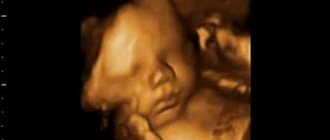To ensure a successful outcome of pregnancy, the health of the fetus and subsequently the newborn baby, a cardiotocographic (CTG) study is required in expectant mothers in the third trimester.
In obstetric practice, CTG during pregnancy is carried out as planned measures to monitor the conditions of the mother and child. Taking into account the clinical picture and certain circumstances, the examination is performed 2 or more times. The number of studies is determined by the gynecologist observing the pregnancy.
What is fetal cardiotocography?
A woman who has received a referral for CTG from the LCD should not worry that this test during pregnancy may somehow harm the baby. This is an absolutely painless and harmless procedure designed to record fetal cardiac activity and uterine contractions over time. For CTG studies, a combination of diagnostic techniques is used, such as phonocardiography simultaneously with Doplerometry.
Cardiotocograph
What does it show?
During CTG, the baby's cardiac function is recorded by an ultrasound sensor with a frequency of 1.5-2 MHz. The obtained data is displayed via digital, sound and light signals, as well as graphically on chart paper.
The result of cardiotocography is presented in two graphs:
- tachogram reflecting the fetal heart rate;
- hysterogram recording the intensity of uterine contractions.
To summarize the purpose of the study, we can say that CTG shows how the contractile activity of the uterus affects the placental blood supply. Based on the data obtained from CTG, the most adequate strategy for labor management is selected.
How long does it take to do it?
The time when CTG is performed during pregnancy sometimes correlates with the circumstances surrounding the gestational period. The most common period at which fetal CTG is performed is 32 weeks of pregnancy. The study makes it possible to timely prescribe the necessary therapy when pathological conditions are confirmed.
A number of experts believe that successful CTG (with obtaining reliable results) before 32 weeks of pregnancy is technically impossible. But if various pathologies are suspected, doctors prescribe a study when the period is 28 weeks, and perform repeated CTG until childbirth and even during labor.
In what cases is it prescribed?
Today, CTG is a prenatal study that is included in the list of standard methods for monitoring intrauterine development, that is, it is carried out in all pregnant women. It was noted above at what week of pregnancy fetal CTG is performed as planned - on the 32nd. Earlier, that is, from the 28th week, CTG can be prescribed if:
- there is a threat of premature birth;
- pathologies in the development of the placenta are observed;
- the fetus is inactive;
- the fetus was found to be entangled in the umbilical cord;
- the mother has chronic diseases or a complicated obstetric history.
An additional procedure may be required if the previous CTG results are questionable.
How is it carried out?
Having learned how CTG is done during pregnancy, women get rid of unnecessary worries and look forward to the procedure, as if they were meeting their baby for the first time, since during the examination the heartbeat will be clearly audible. General characteristics:
- The CTG procedure during pregnancy is carried out using a special device with two sensors equipped with straps.
- Using straps, sensors are attached to the pregnant woman’s belly, one of them records the baby’s heart rate, the other reacts to the tone of the uterus.
- The operation of the tachograph is broadcast through a speaker built into the equipment, so the baby’s heartbeat is transmitted very loudly.
In most clinics, CTG is performed on old equipment that does not respond to fetal movements; the woman must independently monitor the appearance of fetal activity by pressing a special button. This often leads to distorted results, since the expectant mother may not notice a slight movement or may not have time to press the button.
CTG procedure
More modern equipment itself records fetal movements and automatically records the necessary data. The woman can only lie quietly on her side.
How long does it last?
Despite the fact that during the CTG examination a woman is not required to make any effort, many of them are concerned about how long this procedure lasts. This depends on the success of obtaining data, which may require either 30 or 60 minutes. Since dynamic indicators are important for assessing the clinical picture, you often have to wait a long time for the fetus to move and even encourage it to be active if it turns out that the baby has fallen asleep. It is impossible to predict the baby’s behavior inside the womb, therefore, how long a CTG will be done over time most often depends on his behavior.
When is CTG prescribed during pregnancy?
In special cases, experts may recommend CTG during pregnancy from 29 weeks, but usually the test is used after the 31st week of pregnancy, when the examination results will reflect the most reliable data.
Before this period, the fetal organs are still immature, and the data may not be entirely accurate and true. When performing CTG, it is desirable that the child is relatively calm, since the results obtained from CTG will also depend on his movements.
Therefore, the exact timing of the procedure will be determined by the doctor according to indications. Thus, the answer to the question at what time CTG is done during pregnancy will be from 30-32 weeks of pregnancy to childbirth.
How often is CTG done during pregnancy?
If the pregnancy proceeds without any complications, then CTG will not be frequent - they are prescribed no more than twice during the third trimester.
If any complications are detected during pregnancy, CTG is prescribed more often, up to daily monitoring - this study does not cause any harm to the fetus or mother.
In addition, CTG can be performed even during childbirth; this is required in cases where it is necessary to determine the general condition of the child and make a decision on further management of labor.
Children with complicated childbirth, entanglement in the umbilical cord, or other pregnancy pathologies will need special monitoring.
How to prepare for the procedure?
It is useful for the expectant mother to learn how to prepare for CTG during pregnancy, so that during the examination no situations arise that require stopping it. CTG does not require any special preparations. Considering the time it takes place, a woman should make sure that nothing distracts or torments her during the procedure (thirst, hunger, etc.). This is why doctors recommend shortly before CTG:
- have a light snack;
- go to the toilet;
- drink some water.
At the request of the pregnant woman, during the examination she can be in a lying or reclining position, which is important for women with difficulty breathing and other features.
Why do you need to do fetal CTG?
In addition to the fact that cardiotocography demonstrates the condition of the fetal heart, being a kind of extended cardiogram of the unborn baby, this examination can reveal many other developmental abnormalities. First of all, the following pathologies should be included:
- Fetal hypoxia;
- Fetoplacental insufficiency;
- Intrauterine infection;
- High and low water levels;
- Premature maturation of the placenta;
- Threat of premature birth;
- Anomalies in the development of the cardiovascular system.
But it is important to understand that fetal CTG does not always give a 100% result, since there are cases when the data obtained is unreliable for some reason. For example, it happens that the tissues of the child’s body adapt to hypoxia, and the device does not detect a lack of oxygen. Or, on the contrary, the baby may press his head on the umbilical cord, the mother will be nervous before the examination or eat something wrong, and the device will give “bad” results. Therefore, firstly, it is very important to carry out the examination procedure correctly, and secondly, it is also necessary to do additional studies, including ultrasound, Doppler ultrasound, etc.
Norms and interpretation of the result
When summing up and assessing the results of CTG, several indicators of the fetal condition are taken into account:
- basal heart rate (BHR) - the average fetal heart rate, or basal rhythm, recorded for at least 10 minutes;
- variability - the amplitude of the heart rate, a complex parameter of an infant’s cardiac activity, reflecting rhythm deviations from the basal, normally 5-25 beats per minute;
- accelerations – peaks of heart rate acceleration corresponding to high waves on the graph, normally – 2 times in 10 minutes during movements;
- decelerations - slowing down of the rhythm (lower peaks of the teeth), normally - shallow or absent.
Based on a number of factors, an overall assessment of PSP (indicator of fetal condition) is formed - from 0 to 3. On this scale, values of no more than 1 are considered normal for CTG.
- Values in the range from 1 to 2 indicate the risk of initial manifestations of pathological abnormalities in the fetus.
- Values from 2 to 3 increase the likelihood of pronounced deviations in the condition of the fetus.
- If PSP is more than 3, his critical condition is suspected.
CTG recording
There are other scales or measurement systems, for example, those proposed by scientists Gautier and Fisher. According to these scales, assessments of the condition at the time of CHT (32-34 weeks of pregnancy) have a reverse gradation:
- when assessing CTG, 8, 9, 10 points are normal;
- 5-7 points – the result is cause for concern;
- 4 points or less – high probability of significant violations.
The scores are composed of various factors, including fetal heart rate. Guidelines for decoding:
- the range of normal heart rate values in the 3rd trimester is 110-160 beats per minute;
- A fetal heart rate of more than 200 beats per minute indicates tachycardia and the likelihood of cardiac conduction disorders;
- A heart rate below 100 beats is defined as bradycardia, which, as a rule, is a symptom of fetal hypoxia, but can also be a reaction to hypothermia in the mother or her use of certain medications.
Fetal bradycardia during labor can also be observed as a result of prolonged compression of the baby's head by the birth canal. It happens that babies who have had intrauterine bradycardia for a long time are born without pathological abnormalities, including hypoxia.
Experts recommend a differentiated and cautious approach to fetal cardiotocography indicators, since interpretation of CTG recordings is not a diagnosis.
What is fetal CTG during pregnancy?
Cardiotocography is carried out during pregnancy in order to obtain data on the heart contractions and the work of the fetal heart in combination with its motor activity, contractions of the uterus and the reactions of the fetus to this.
Typically, this study in pregnant women is combined with ultrasound and Dopplerometry (a special study of blood flow in the vessels of the placenta, umbilical cord and fetus).
These examinations make it possible to identify any abnormalities during pregnancy that impede the normal development of the child, which will allow the doctor to prescribe treatment in a timely manner.
Review Reviews
The fact that CTG is a safe and painless procedure is also evidenced by reviews of expectant mothers who have undergone this study. Most women describe with delight their sensations when they heard the loud beating of a small heart inside themselves, listened to the baby’s movements, and “stirred” him so that he would wake up.
Many expectant mothers, especially at 40 weeks of pregnancy, had problems with insufficient fetal activity, which is why the CTG device could not record heart rate dynamics. Women shared their experiences on how best to “wake up” the baby and get him to move (on the advice of obstetricians at the LCD):
- shortly before the procedure, drink juice, eat an apple, carrot or chocolate candy;
- during CTG - stroke or comb the stomach, tap it with your fingers, gently push it;
- breathe deeply.
If the baby managed to sleep through the entire “session” of cardiotocography, women, judging by the reviews, had to extend the study by more than 60 minutes or repeat it a few days later.
If the CTG device manages to record the baby’s heart rate both in a calm state and with active movement and no deviations are detected, the procedure lasts no more than 20 minutes.
Interpretation of fetal CTG
The results obtained after examination on a cardiotocograph must be deciphered by a doctor. The data obtained, as in any analysis or survey, is compared with norms. But no diagnoses are made here - since the examination only provides additional data along with other research methods. In addition, the data obtained must be treated with caution, judiciously comparing it with data from other examinations, and only a doctor can do this professionally. But, if you think that your doctor did not decipher the data obtained clearly enough, use the table.
| Norm | Possible violations | Serious violations (threat to the life of the child) | |
| Number of points | 9-12 | 6-8 | 5 or less |
| BHR (bpm) | 119-160 at rest, 130-190 - in the active phase | 100-119 or more than 160 | 100 and less or more than 180 |
| Verability | within 5-25 per minute | less than 5 or more than 25 | less than 5 or more than 25 |
| Rhythm | undulating or saltatory | monotonous or slightly undulating | monotonic or sinusoidal |
| Number of accelerations | 2 or more | less than 2 or absent | little or no |
| Number of decelerations | No | shallow and short | late and probable |
| Fetal health indicator (FSI) | less than 0.8 | 1,05-2,0 | 2.01-3.0 and above |











